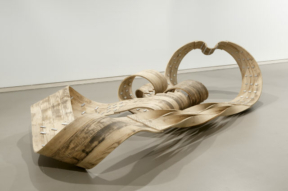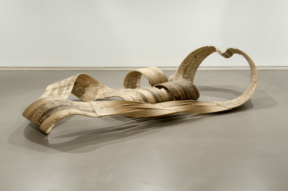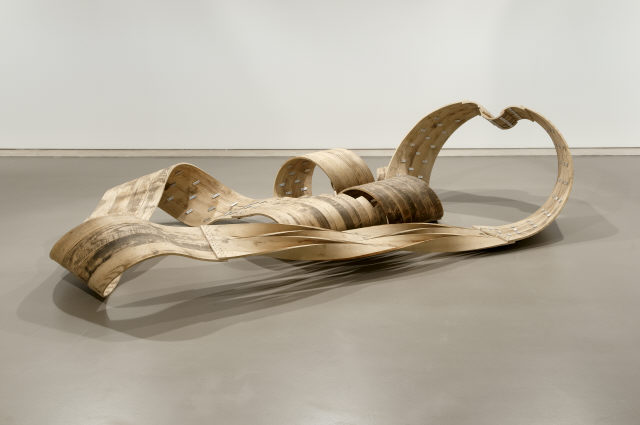
- 2001
- Wood, Ash and Aluminum
- A definir
- Inv. EE65
Richard Deacon
UW84DC#14
UW84DC#14 formed part of an installation comprising fifteen sculptures with the same title which were presented at the Dundee Contemporary Arts in 2001. The title, which is written as a text message on a mobile phone, corresponds somewhat cryptically to “you wait for the sea”. The series of works suggested the movement of the sea in the swirling of the wood, which seemed to move with the properties of water.* This image, which is remarkable for an exhibition of sculptures in wood and aluminium, is in harmony with the enigmatic name of the installation and its exhibition in the industrial city of Dundee, close to the North Sea.
The sculptor creates a link between language and matter, observing that both are fabricated by man and that both constitute themselves to the extent that they are worked on and used. Both generate their own meaning, and this idea lies at the heart of his artistic thinking. Deacon sees himself as a fabricator, as a creator of forms that are necessarily useless but which express, and which aim to symbolise, the human experience of the world. His sculptures combine organic and biomorphic forms with engineering elements by examining the way that a form is fixed and working on the idea of “inside” and “outside”, the idea of a finite form, contained by its outline but at the same time escaping from it. For a sculptor who enjoys drawing clouds, there is in Deacon’s work an appreciation of a certain indefinite or ambiguous quality, in contrast to the delicate, magisterial mode which dominates his material execution. The baroque spirit is very much present in his work – Deacon is an enthusiastic admirer of Bernini – in the idea of the disciplined manifestation of the treatment of form, in tandem with the desire for a potential plasticity or fluidity, which remains latent.
The installation UW84DC was exhibited together with a sound installation called Umhh, 2000,** a tangle of interjections and odd, superfluous words resulting from the editing of a recorded interview. Presented together, the sequence of sounds and forms refers to the Leibnizian “fold” of the baroque,*** in which there is no centre and no starting point from which to view knowledge, knowledge being, by contrast, polycentric and polysemantic. Deacon demonstrates here that there is both an attractive and a repulsive side to knowledge when we face up to something that takes us unawares (in a physical sense also) and we devote ourselves to making it significant. In the apparent formal incongruity of these shreds of gigantic pencils,**** his sculpture expresses the (perhaps futile, but certainly intense) challenge of our swift passage through the world.
Ana Vasconcelos
May 2010
* Vikki Bell, «Richard Deacon. Sculpture», in Richard Deacon, Dundee, Dundee Contemporary Arts, 2001, p. 9.
** Created together with Martin Kreybig.
*** As worked by Gilles Deleuze, quoted by Clarrie Wallis in «Out of Order», Richard Deacon. Out of Order, St. Ives, Tate St Ives, 2000, p. 31.
**** Vikki Bell, op. cit., p. 9.
| Type | Value | Unit | Section |
| Width | 357 | cm | |
| Depth | 159 | cm | |
| Height | 83 | cm |
| Type | Acquisition |




